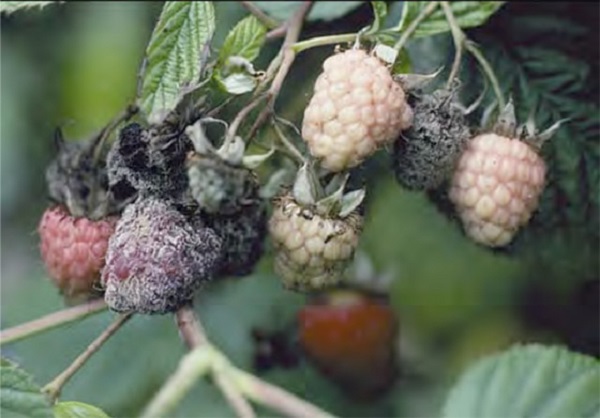Raspberries belong to the category of prickly shrubs, which have powerful rhizomes and a large number of shoots. Growing shrubs in one place should be no more than 7 years. Otherwise, there is a decrease in size and looseness of the root system of this plant.
In this article, we will look at the main diseases of raspberry, find out why leaves can dry or rot berries on a bush and how to deal with it.
Table of contents
The main reasons why garden raspberry dries
Garden raspberries need to ensure optimal growth conditions. Otherwise, it will dry out. The reason for drying is improper care for it, which is due to insufficient watering, poor light, and poor soil.
The cause of the drying of this plant become infectious diseases. The infection penetrates through mechanical damage. Drying of berries, leaves and shoots is observed as a result of the wilt virus, which is classified as a dangerous disease.
During the development of this disease, raspberry leaves quickly turn yellow, and the tops of the trunks dry out.When planting bushes next to zucchini, tomatoes, potatoes and eggplants can be observed drying. This is because these plants are the causative agents of mold fungi, which are harmful to the plant.
Raspberries can hurt for various reasons. They are not in the wrong care of shrubs, and in diseases.
Why do raspberry leaves dry up?
Drying of leaves of a bush is observed as a result of development of diseases. Often it happens as a result of the development of root cancer. With its development, there is a loss of taste of berries. New shoots of shrubs are characterized by small size, the leaves become yellow. In the summer they begin to fall off.
Infectious chlorosis or jaundice is a common cause of yellowing shrub leaves. This disease is infectious. With the development of this disease on young shoots often turn yellow leaves. Berries are characterized by a dry and unpleasant taste. The fight against the disease is to eliminate the affected shoots.
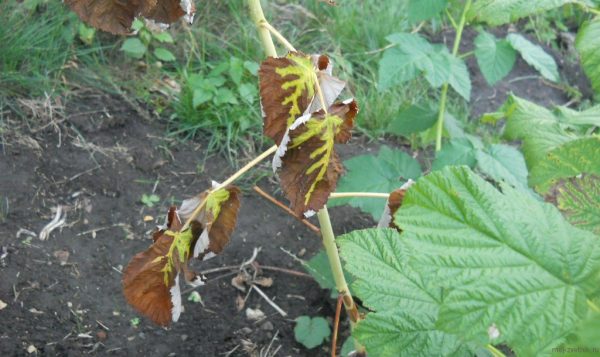
Gardeners have noted yellowing of the leaves and with non-infectious chlorosis, the cause of which is the wrong tillage and adverse climatic conditions.When infecting a shrub, there is a change in the color of its leaves. On healthy shoots, the size of the foliage increases.
Why can raspberry berries dry up?
Drying raspberry berries can be observed as a result of diseases, such as infectious contagious chlorosis. During the development of this disease, yellowing of the foliage is observed. By the fall, it becomes normal color. This disease has virtually no effect on the level of yield. But the berries become dry and lose their taste. They have a lot of seeds. Stalks of diseased plants become thick and low.
Berries can dry out together with the tops of the plant as a result of exposure to gall midges. With the development of this disease, shoots and cracks are observed on the shoots. If the shrub is grown in one place for more than 5 years, then as a result of this, there may be a decrease in the size of the berries and their drying. If the shrub is affected by vetilisous wilt, then the plant wilting is observed from the tops of the berries.
The drying of berries is affected by diseases that arise as a result of improper care of the shrub.
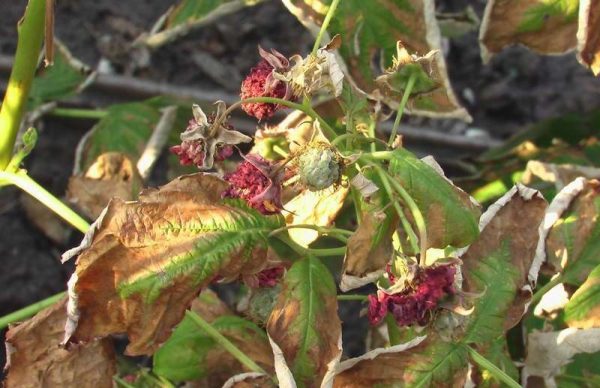
The main diseases of raspberry and their symptoms
Raspberries belong to the category of shrubs, which under adverse conditions may be subject to diseases, and the negative effects of pests.
Both diseases and pests are dangerous for this plant. That is why it is necessary to start pest control and treat diseases in a timely manner.
You may also be interested in the following articles about raspberries:
White and purple spot
White purple blotch belongs to the category of fungal diseases. The disease affects young growing shoots near the attachment of the leaves to the stems. Raspberry trunks are covered with white or brown spots in a black dot.
To combat the disease, you need to often dig up and weed the soil, and mulch it. The plant can be treated with insecticide. The ideal option for dealing with this disease is 0.3% malathion. It is possible to spray with konfidor.
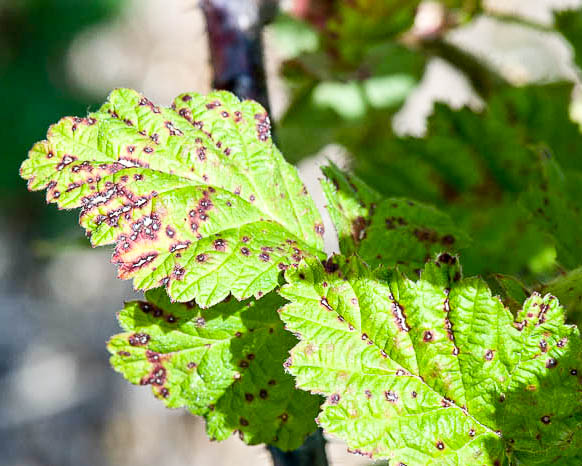
Bacterial root cancer
Root cancer leads to a deterioration in the growth of raspberries and the loss of taste qualities by the berries, and the foliage of the plant turns yellow. The fight against this disease is problematic, since the use of insecticides is prohibited. Shrubs that are affected by root cancer are dug out and burned.
This eliminates the possibility of spreading the disease.
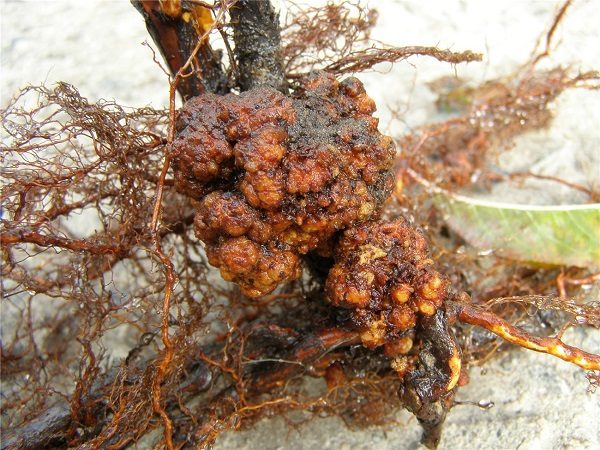
Fungal diseases of raspberry (anthracnose and gray rot)
Raspberries are susceptible to fungal infections such as gray mold and anthracnose. Symptoms of anthracnose are most often observed in conditions of high humidity in growing shrubs. This fungal disease is manifested by leaf spotting, which is brown in color. The shoots affected by the disease must be carefully cut and removed from the site.
The emergence of gray rot on raspberries is observed as a result of exposure to multicellular mycelium. The disease manifests itself at the initial stage of berry ripening. The disease is initially manifested by the appearance of brown spots in the places of contact of the fruit. After a few days, the whole fetus is covered by the disease, resulting in necrosis.
To combat gray rot during the raspberry budding process, chemical treatment is necessary. For this purpose, fungicides can be used in the form of Fundazole 50 SP, Rovral, Sumlex 50 SP, Ronilan, etc. Of the application must be carried out in strict accordance with the instructions.
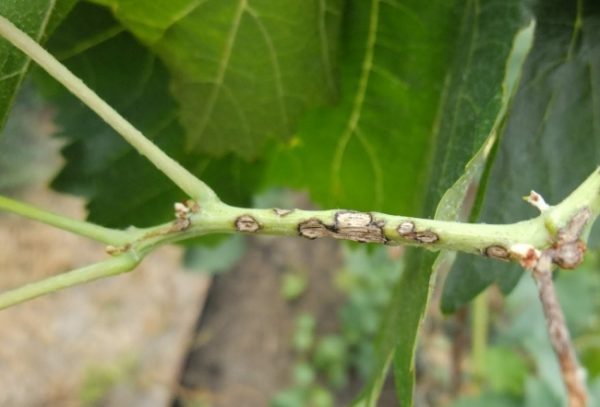
Raspberry mosaic
Mosaic is a common disease of raspberry, which can manifest itself in different ways, depending on the variety. It can manifest itself in the form of a mosaic of leaves or their deformation. Affected bushes are characterized by weak shoots.
The disease is controlled with the use of insecticides - Hostedion 40 KS, Marshal 25 CE, Kronetona 50 Oe, Ortena 75 JV.
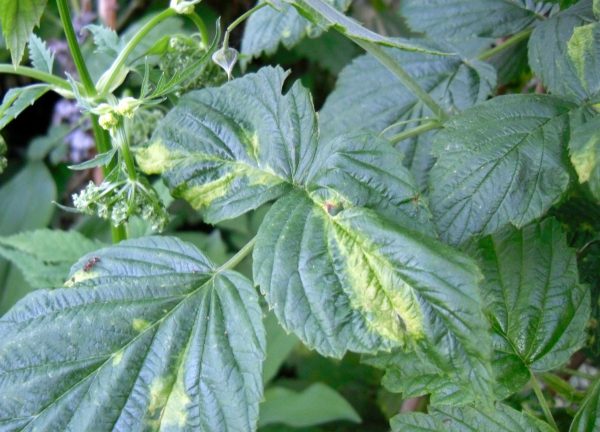
Rust
Rust on raspberries is a fungal disease, with the appearance of which dark spots appear on the lower part of the leaves. As a result, the leaves of the plant wither and fall.With a strong neglect of the disease on the stems brown spots appear.
At infection of raspberry bushes their destruction is made. In the spring and autumnal period is sprayed. For this purpose, a solution of 1% Bordeaux liquid is used.
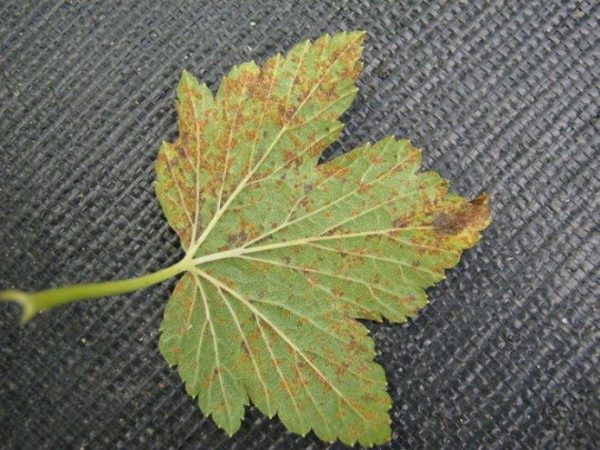
Ulcer spot
This disease is most often observed on older plants. The disease manifests itself as brown spots on the shoots. In the summer, there may be a sudden drying of the plant. In order to avoid the appearance of the disease, it is necessary to remove two-year-old shoots after harvesting.
During the growing season the shrub must be processed Bordeaux mixture. Before flowering, the plant must be treated with such insecticides as Topsin M70, Impact 12 SC, Alto 100 SL, etc.
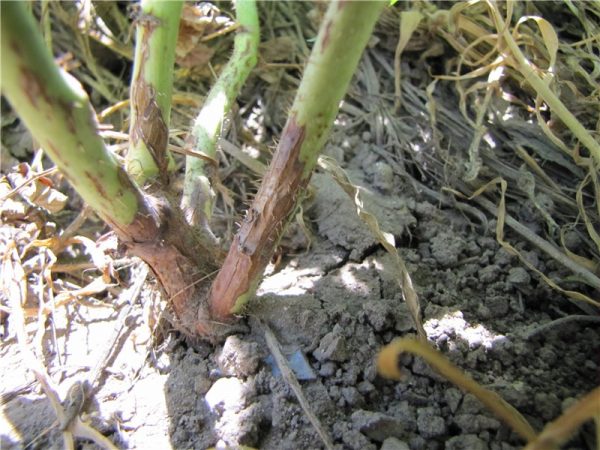
Witch's broom
Witch broom on raspberries occurs as a result of phytoplasma. With the development of this disease at the base of shrubs a large number of shoots are formed.
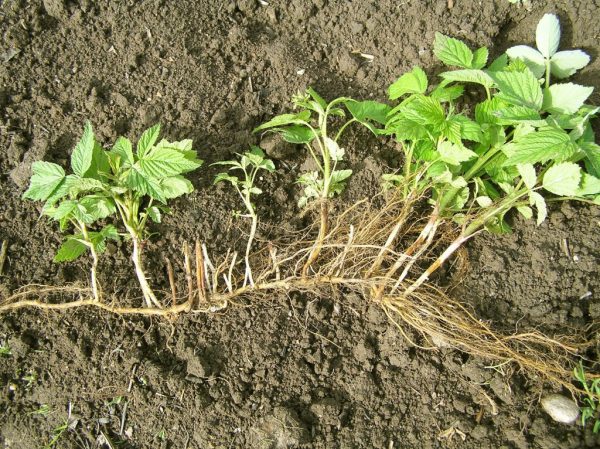
Pest on raspberries and fight them
Pests can cause irreparable harm to raspberries. They adversely affect not only the fruits of the plant, but also the stems, the root system.
That is why when they occur, it is necessary to carry out timely combat with them. For this purpose, in most cases insecticides are used. In order to avoid the appearance of pests on raspberries, it is recommended to carry out preventive measures.
Raspberry-strawberry weevil
The weevil is a small black bug that damages the raspberries with its long nose. To combat this pest, it is recommended to treat the bushes with garlic infusion.A solution of manganese potassium can be used to eliminate the pest.
Raspberries should be processed in the morning or in the evening. In order to avoid the appearance of weevil between raspberries planted garlic or onions.
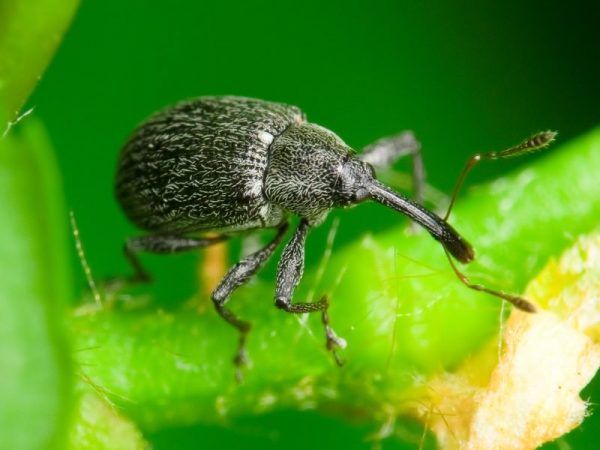
Raspberry beetle
Raspberry beetle has a brown color and reaches a length of 4 centimeters. It damages the flowers and the ovary of the raspberry. the raspberry beetle damages the shoots and leaves of the plant. During the budding period, beetle plants are harvested by hand. If there are larvae in the damaged berry, then they need to be killed.
In the autumn, it is recommended to dig the soil. For pest control, insecticidal plants are used to prepare infusions. Insecticides are purchased to fight insects in a specialty store.
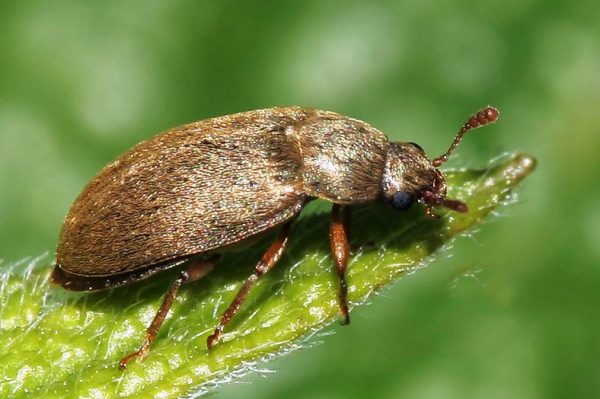
Raspberry stem gallitsa
Galitsa is the main pest of raspberries. This is a black insect that grows up to 2.5 centimeters in length. Insect is characterized by the presence of transparent wings. Pests climb under the bark of the plant and winter there.
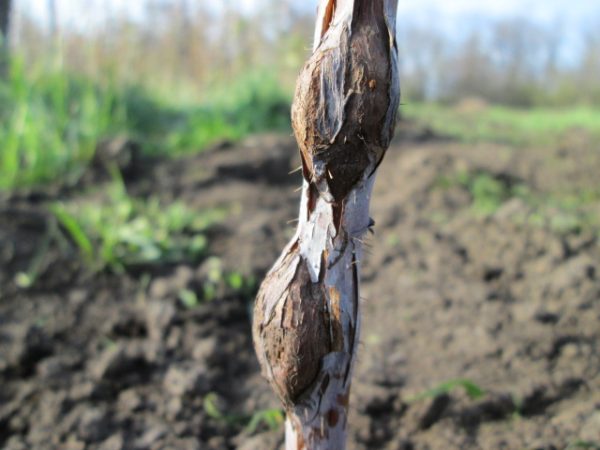
Raspberry glass bowl
The butterfly lays eggs on the soil surface near the raspberry bushes. Its larvae damage shrub stalks. If, when inspecting a raspberry, a stem fly was found, then it is necessary to immediately cut and burn the tops of the bushes. If there is a larva in the stem, then the stem is cut closer to the root. In the autumn, the soil should be carefully loosened.

Raspberry fly stem
The crimson stem fly is a small insect whose length is no more than 5 millimeters.It is characterized by a green color and the presence of transparent wings. The pest overwinters under raspberry bushes. Since May, the flies produced laying eggs in the upper leaves.
The larvae of flies penetrate the stem, which leads to the withering of the shoots. The fight is to eliminate damaged shoots. If this procedure is ineffective, then insecticides should be used.
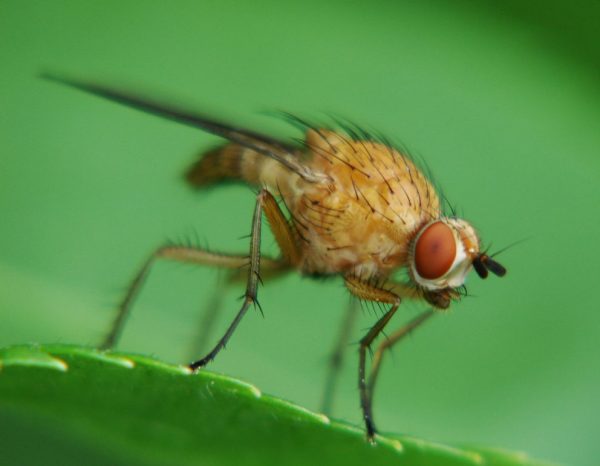
Methods of treatment and prevention
With the wrong care, raspberries can be exposed to various diseases. negative impact on its growth and development have a pest. To ensure a rich harvest it is necessary to carry out timely prevention of its pests and diseases. To this end, you need:
- Eliminate weeds;
- To conduct autumn digging of the soil;
- Remove old shoots;
- Conduct timely pruning of the plant;
- Treat bushes Bordeaux mixture in the fall and spring.
Raspberries are a useful shrub whose berries are used not only for food, but also for the treatment of diseases.Improper care leads to the appearance of pests and diseases on this plant.
In order to be able to eat raspberries in food, the fight against them must be carried out by mechanical methods or with the use of safe insecticides. In order to avoid the appearance of pests and diseases, it is necessary to carry out their prevention in a timely manner. Its implementation does not require the expenditure of effort and money.
In conclusion, we propose to watch a short video about raspberry diseases and pests, as well as ways to combat:
